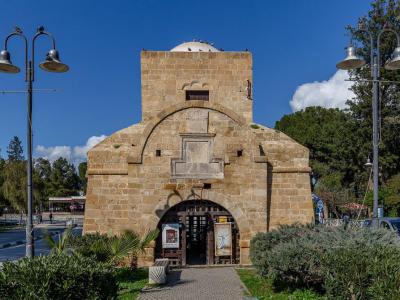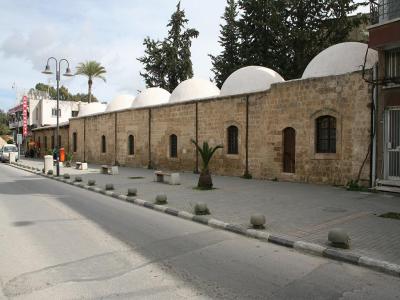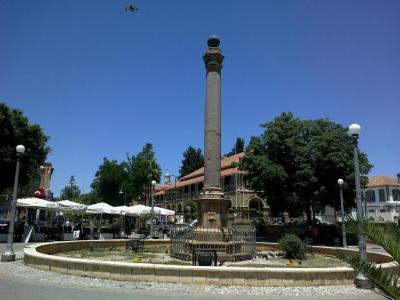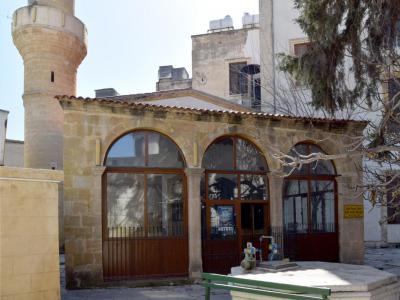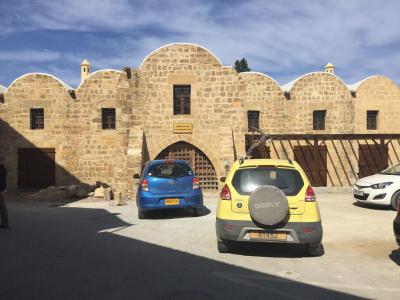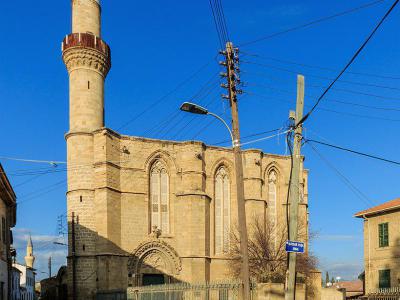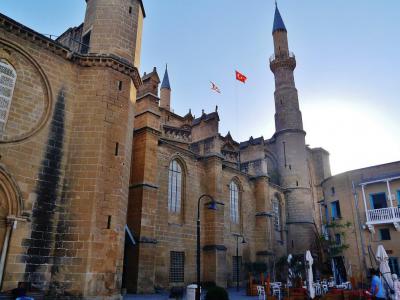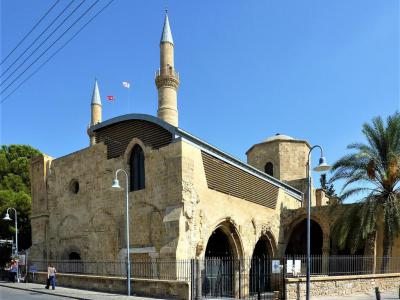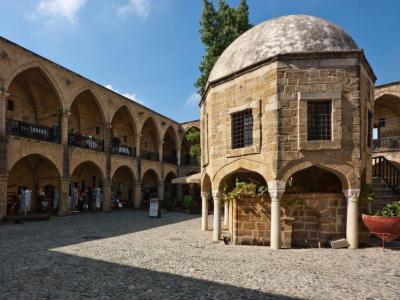
Turkish Old Town Walking Tour (Self Guided), Nicosia
Nicosia wasn't always Nicosia. It was originally called Leukosia. In Greek mythology Leukosia was a siren, a daughter of Achelous, a river god, and Melpomene, Muse of Tragedy. They had several daughters, Leukosia was one.
Others say the first settlers were Achaean veterans of the Trojan War. They appeared on the plain of Mesaoria by the river Pedieos in 2,500 BC. They formed the city state, Ledra. Traces of Ledra have been found on the hill Ayia Paraskevi, south of the town.
In 965 the Byzantines chose Leukosia to be the official capital of Cyprus. In 1188 Richard I besieged Leukosia. He conquered, then sold the island to the Knights Templar. Frankish rule in Cyprus ran until 1489. The Lusignan kings built the city walls, palaces and churches, including St. Sophia Cathedral.
The Lusignians could not pronounce the name Leukosia. They managed "Nicosie." From there it was a rose by any other name, so to speak. In 1489 the Venetians came to call and stayed. They busied themselves fortifying the island against the Ottoman threat.
The new walls were star-shaped with eleven bastions. There were three gates, Kyrenia, Paphos and Famagusta. The river Pedieos was diverted to form a moat. All to no avail. In 1570 Ottomans devastated the city and converted churches and some public buildings into mosques.
British rule came in 1878. In 1955 a rebellion attempted to unite the island with Greece. In 1960 Nicosia became the capital of the independent Republic of Cyprus. Civil strife resulted in a Turkish invasion in 1974 followed by a partitioning of the island.
A Green Line divides the old city of Nicosia into two. North of the green line lies the Turkish old town where the city mosques, baths and markets are mostly converted from Byzantine, Venetian and Lusignan structures. St. Sophia's Cathedral is now the Selimiye Mosque.
Narrow pedestrianized market streets wind their way through the Turkish old town. There are secret gardens and hamams, ancient bath houses, some open to the public. The graceful minarets call to prayer. The east and west meet in Nicosia, reconciled once more.
Others say the first settlers were Achaean veterans of the Trojan War. They appeared on the plain of Mesaoria by the river Pedieos in 2,500 BC. They formed the city state, Ledra. Traces of Ledra have been found on the hill Ayia Paraskevi, south of the town.
In 965 the Byzantines chose Leukosia to be the official capital of Cyprus. In 1188 Richard I besieged Leukosia. He conquered, then sold the island to the Knights Templar. Frankish rule in Cyprus ran until 1489. The Lusignan kings built the city walls, palaces and churches, including St. Sophia Cathedral.
The Lusignians could not pronounce the name Leukosia. They managed "Nicosie." From there it was a rose by any other name, so to speak. In 1489 the Venetians came to call and stayed. They busied themselves fortifying the island against the Ottoman threat.
The new walls were star-shaped with eleven bastions. There were three gates, Kyrenia, Paphos and Famagusta. The river Pedieos was diverted to form a moat. All to no avail. In 1570 Ottomans devastated the city and converted churches and some public buildings into mosques.
British rule came in 1878. In 1955 a rebellion attempted to unite the island with Greece. In 1960 Nicosia became the capital of the independent Republic of Cyprus. Civil strife resulted in a Turkish invasion in 1974 followed by a partitioning of the island.
A Green Line divides the old city of Nicosia into two. North of the green line lies the Turkish old town where the city mosques, baths and markets are mostly converted from Byzantine, Venetian and Lusignan structures. St. Sophia's Cathedral is now the Selimiye Mosque.
Narrow pedestrianized market streets wind their way through the Turkish old town. There are secret gardens and hamams, ancient bath houses, some open to the public. The graceful minarets call to prayer. The east and west meet in Nicosia, reconciled once more.
How it works: Download the app "GPSmyCity: Walks in 1K+ Cities" from Apple App Store or Google Play Store to your mobile phone or tablet. The app turns your mobile device into a personal tour guide and its built-in GPS navigation functions guide you from one tour stop to next. The app works offline, so no data plan is needed when traveling abroad.
Turkish Old Town Walking Tour Map
Guide Name: Turkish Old Town Walking Tour
Guide Location: Cyprus » Nicosia (See other walking tours in Nicosia)
Guide Type: Self-guided Walking Tour (Sightseeing)
# of Attractions: 13
Tour Duration: 2 Hour(s)
Travel Distance: 2.2 Km or 1.4 Miles
Author: Cathy
Sight(s) Featured in This Guide:
Guide Location: Cyprus » Nicosia (See other walking tours in Nicosia)
Guide Type: Self-guided Walking Tour (Sightseeing)
# of Attractions: 13
Tour Duration: 2 Hour(s)
Travel Distance: 2.2 Km or 1.4 Miles
Author: Cathy
Sight(s) Featured in This Guide:
- Kyrenia Gate
- Mevlevi Tekke (Whirling Dervishes Museum)
- Atatürk Square
- Arabahmet Mosque
- Iplik Pazari (Iplik Bazaar Mosque)
- Büyük Hamam
- Kumarcilar Han
- Haydarpasa Mosque
- Selimiye Mosque
- Bedesten (Covered Marked)
- Belediye Pazarı (Bandabuliya Municipal Market )
- Büyük Han (Great Inn)
- Arasta Street
1) Kyrenia Gate
"...O, the opener of the gates, open gates that lead to good." Sayyid Fazullah Dede, a descendant of the Prophet, inscribed this prayer on a tablet at the Kyrenia Gate to Old Nicosia in 1821.
The gate was installed in the city walls by Venetians in 1576. They had a plaque in Latin with the date "MDLXII" (1562). The British covered the tablet of Sayyid Dede with their own in 1931, also in Latin, "George V, King and Emperor." Empires have come and gone but the gate remains.
There are three gates to the walled city of the Venetians. The Paphos Gate, The Famagusta Gate and the Kyrenia Gate. The traditional entrance to the Turkish part of the Old City is the Kyrenia Gate.
The gate was called "Door of the Proveditore" by the Venetians. The name "Proveditore" is taken to mean "Military Governor" in Italian. It is similar to "Provost Marshal" in English. It has also been named for whoever was governor at the time. Because of an armory west of the Gate, it has also been called "Door of the Fortress."
The Gate is a brief alley under rounded arches. Above the gate is a square sentry room topped with a dome. The Ottomans built the upper floors to guard against a Greek uprising in the Old City. The walls on both sides of the gate were demolished in 1931 to make room for road lanes on either side.
The gate was installed in the city walls by Venetians in 1576. They had a plaque in Latin with the date "MDLXII" (1562). The British covered the tablet of Sayyid Dede with their own in 1931, also in Latin, "George V, King and Emperor." Empires have come and gone but the gate remains.
There are three gates to the walled city of the Venetians. The Paphos Gate, The Famagusta Gate and the Kyrenia Gate. The traditional entrance to the Turkish part of the Old City is the Kyrenia Gate.
The gate was called "Door of the Proveditore" by the Venetians. The name "Proveditore" is taken to mean "Military Governor" in Italian. It is similar to "Provost Marshal" in English. It has also been named for whoever was governor at the time. Because of an armory west of the Gate, it has also been called "Door of the Fortress."
The Gate is a brief alley under rounded arches. Above the gate is a square sentry room topped with a dome. The Ottomans built the upper floors to guard against a Greek uprising in the Old City. The walls on both sides of the gate were demolished in 1931 to make room for road lanes on either side.
2) Mevlevi Tekke (Whirling Dervishes Museum)
Here is a 17th century Tekke, or Dervish house, now a museum. It was a center for followers of the Mevlevi Order. The Mevlevi were a branch of Sufi (mystical) Islam. They are better known as "whirling" dervishes.
Their spinning dances could produce a trance-like meditative state of serenity and peace. The dervishes would move to the melody of a reed flute, a lute and a drum. Inside the museum are figures of whirling dervishes accompanied by a trio in the gallery. There are musical instruments, costumes and Turkish artifacts.
The Mevlevi sect was founded in Konya, Turkey in the 13th century by the mystic poet Mevlana Rumi. It is believed that the tekke of Nicosia was built in 1593 by Arab Ahmed Pasha on his own land. The compound was later enlarged by land donated by Lady Emine Hatun. By 1607 the tekke was demolished and rebuilt by Ferhad Pasha.
The building is an Ottoman classic in modern Nicosia. The structures extant today are the semehana, where the whirling seme dance rituals are held, the tomb, a few rooms and a yard. The tekke of 1607 had rooms for dervishes, guest rooms, a kitchen and a garden. There is a mausoleum with sarcophagi of spiritual leaders including Selim Dede.
Their spinning dances could produce a trance-like meditative state of serenity and peace. The dervishes would move to the melody of a reed flute, a lute and a drum. Inside the museum are figures of whirling dervishes accompanied by a trio in the gallery. There are musical instruments, costumes and Turkish artifacts.
The Mevlevi sect was founded in Konya, Turkey in the 13th century by the mystic poet Mevlana Rumi. It is believed that the tekke of Nicosia was built in 1593 by Arab Ahmed Pasha on his own land. The compound was later enlarged by land donated by Lady Emine Hatun. By 1607 the tekke was demolished and rebuilt by Ferhad Pasha.
The building is an Ottoman classic in modern Nicosia. The structures extant today are the semehana, where the whirling seme dance rituals are held, the tomb, a few rooms and a yard. The tekke of 1607 had rooms for dervishes, guest rooms, a kitchen and a garden. There is a mausoleum with sarcophagi of spiritual leaders including Selim Dede.
3) Atatürk Square
Ataturk Square was named in honor of Mustafa Kemal Ataturk, founding father of modern Turkey. The change was made by the municipal authority of Nicosia, led by Themistoklis Dervis. It is said Mr. Dervis was fishing for the Turkish Cypriot vote. But locals still refer to the square as "Sarayonu", meaning "the front of the palace."
The palace is gone. It was the royal French residence of the Lusignan dynasty. The Lusignans ruled Cyprus until the 15th century, when the island was annexed by Venice. The Venetians erected a granite column surmounted by a lion in front of the palace.
The column was believed to have been taken from the old Temple of Zeus at Salamis. The Ottomans arrived in 1570. They stored the column in the Sarayonu Mosque, which had been a Carmelite church. The lion of the Crusaders was replaced by a British globe when it was moved to the Square in 1915.
The fountain at the square by the law Courts was built in the Ottoman period. It is octagonal in shape with one fountain in a niche on each side. It is maintained by the Turkish Cypriot Department of Antiquities, but it ran dry long ago.
The central Law courts, the Nicosia Post Office, a police station and several banks are around the square. The old palace is gone, razed by the British. However, there is a hotel, also called Saray. You can go to its rooftop restaurant, have a drink and enjoy a view of the entire city.
The palace is gone. It was the royal French residence of the Lusignan dynasty. The Lusignans ruled Cyprus until the 15th century, when the island was annexed by Venice. The Venetians erected a granite column surmounted by a lion in front of the palace.
The column was believed to have been taken from the old Temple of Zeus at Salamis. The Ottomans arrived in 1570. They stored the column in the Sarayonu Mosque, which had been a Carmelite church. The lion of the Crusaders was replaced by a British globe when it was moved to the Square in 1915.
The fountain at the square by the law Courts was built in the Ottoman period. It is octagonal in shape with one fountain in a niche on each side. It is maintained by the Turkish Cypriot Department of Antiquities, but it ran dry long ago.
The central Law courts, the Nicosia Post Office, a police station and several banks are around the square. The old palace is gone, razed by the British. However, there is a hotel, also called Saray. You can go to its rooftop restaurant, have a drink and enjoy a view of the entire city.
4) Arabahmet Mosque
Many mosques in Nicosia are converted churches. The Arabhamet Mosque however, was built as a mosque on the site of a demolished Latin Church. It is designed in the Anatolian style. It is square with a domed roof and a single tall minaret. It is named for Ahmet Pasha, a senior commander of the Ottoman army of the 16th century.
The building has extensive renovations in the 19th and 20th centuries. The interior is simple, carpeted, with a green pulpit. But the mosque holds a secret. The stone floors under the carpets are made from the tombstones of French crusader knights. The stones are part of the salvage from the old church. One is for Louis de Nores, 1369.
Among the relics of the Mosque is a hair believed to have been culled from the beard of the Prophet. It is shown to believers once a year. The tomb of Kamil Pasha is here. He was the only Cypriot to become Grand Vizier of the Empire four times. The serene shaded garden holds the white marble tombstones of several distinguished pashas.
The building has extensive renovations in the 19th and 20th centuries. The interior is simple, carpeted, with a green pulpit. But the mosque holds a secret. The stone floors under the carpets are made from the tombstones of French crusader knights. The stones are part of the salvage from the old church. One is for Louis de Nores, 1369.
Among the relics of the Mosque is a hair believed to have been culled from the beard of the Prophet. It is shown to believers once a year. The tomb of Kamil Pasha is here. He was the only Cypriot to become Grand Vizier of the Empire four times. The serene shaded garden holds the white marble tombstones of several distinguished pashas.
5) Iplik Pazari (Iplik Bazaar Mosque)
Named for a cotton market that once occupied the neighborhood, the Iplik Bazaar Mosque was built near the end of the 18th century to replace the Haci Ahmet Aga Mosque. It was restored in 1826 and once more in 1899. The last restoration was done under the direct supervision of Mehmet Sadik, director of the Evkav Trust for Islamic Estates.
The plastered sandstone style of the mosque is uncomplex and unique, peculiar to Cyprus. It has a boxy rectangular shape. The ornate wooden ceiling is supported by arches and there is a portico on the front side. In the mosque yard there is a stone hexagonal well.
The old minaret is from the Haci Ahmet Aga Mosque. It is short for a minaret and it has a single balcony. The conical stone top is unusual for a minaret. The mosque is located in the merged Iplik Bazaar-Korkut Effendi neighborhood within the old walled city.
The plastered sandstone style of the mosque is uncomplex and unique, peculiar to Cyprus. It has a boxy rectangular shape. The ornate wooden ceiling is supported by arches and there is a portico on the front side. In the mosque yard there is a stone hexagonal well.
The old minaret is from the Haci Ahmet Aga Mosque. It is short for a minaret and it has a single balcony. The conical stone top is unusual for a minaret. The mosque is located in the merged Iplik Bazaar-Korkut Effendi neighborhood within the old walled city.
6) Büyük Hamam
Next door to the Iplik Bazaar Mosque is the Buyuk Hamam, the Turkish bath house of the Iplik Bazaar-Korkuk Effendi neighborhood. Among the first changes the Ottomans initiated after acquiring Cyprus in 1570 was the construction of public baths, called "hamams."
The baths functioned as social centers and places to cleanse both body and spirit. Most citizens did not have such facilities of their own, so the baths were especially welcome.
Büyük Hamam is the oldest Turkish bath in town. It was built on the 14th century site of Saint George de Poulins Church. Elements of the Church can be seen in the main entrance to the Baths.
Much of the Ottoman construction took place on the ruins of the former city. One effect of this was the rise of the ground level. The Hamam main entrance is now below street level. The actual baths are lower than that.
The Hamam is in three separate parts. There is the changing room, which still has elements of the original Latin church. Next is a room where bathers may warm up or cool down. Lastly a thermal or "hot" room. The thermal room has a large dome with windows for sunlight over the massage podium.
Büyük Hamam is the only functioning old Turkish bath in North Cyprus. Visitors may use the baths and avail themselves of traditional peelings and massages with aromatic oils. The baths are open everyday. Gender segregated and family sessions can be arranged.
The baths functioned as social centers and places to cleanse both body and spirit. Most citizens did not have such facilities of their own, so the baths were especially welcome.
Büyük Hamam is the oldest Turkish bath in town. It was built on the 14th century site of Saint George de Poulins Church. Elements of the Church can be seen in the main entrance to the Baths.
Much of the Ottoman construction took place on the ruins of the former city. One effect of this was the rise of the ground level. The Hamam main entrance is now below street level. The actual baths are lower than that.
The Hamam is in three separate parts. There is the changing room, which still has elements of the original Latin church. Next is a room where bathers may warm up or cool down. Lastly a thermal or "hot" room. The thermal room has a large dome with windows for sunlight over the massage podium.
Büyük Hamam is the only functioning old Turkish bath in North Cyprus. Visitors may use the baths and avail themselves of traditional peelings and massages with aromatic oils. The baths are open everyday. Gender segregated and family sessions can be arranged.
7) Kumarcilar Han
After a hard scrub with black soap and a hammering massage at one's favorite Hamam, check in at the old Gambler's Inn. The Gambler's Inn is a roadside inn, maybe built in the 17th century. Located in North Nicosia, it is one of the many roadside inns scattered throughout the old Islamic world. It was originally called as the Violinist's or Fiddler's Inn. It's not known when, or why, the name changed, or if gambling ever occurred at this place.
The inn is smaller than Great Inn (Buyuk Han), Nicosia's other roadside inn. After passing through the main entrance, one encounters an open courtyard. The courtyard is surrounded by the two-story inn. Originally, the inn had 56 rooms. The upper story was for travelers. The lower story was used for animals and storage. As of 2008 the inn was dilapidated.
Rejoice. As of 2018, the inn was restored and usable. It serves, as of today, as a cafe/restaurant. There are also shops for local artifacts in the rooms once used for storage. In 1936, Rupert Gunnis, patron of the Cyprus Museum, called Kumarcilar Han the "Kahn of Itinerant Musicians." What groups played there is not known.
The inn is smaller than Great Inn (Buyuk Han), Nicosia's other roadside inn. After passing through the main entrance, one encounters an open courtyard. The courtyard is surrounded by the two-story inn. Originally, the inn had 56 rooms. The upper story was for travelers. The lower story was used for animals and storage. As of 2008 the inn was dilapidated.
Rejoice. As of 2018, the inn was restored and usable. It serves, as of today, as a cafe/restaurant. There are also shops for local artifacts in the rooms once used for storage. In 1936, Rupert Gunnis, patron of the Cyprus Museum, called Kumarcilar Han the "Kahn of Itinerant Musicians." What groups played there is not known.
8) Haydarpasa Mosque
It seems that the mosques of Nicosia are built on the remains of old Catholic churches. The Haydarpasa Mosque on Kirlizade Street is no different. It was built in the 14th century as Saint Catherine's Church. Sir Harry Charles Luke, while secretary to the Lord High Commissioner of Cyprus, called it the finest Gothic edifice on the island.
The Ottomans conquered the island in 1570 and poof! the church became a mosque. It was the favorite mosque of the local Turkish aristocracy. The right side of the mosque is rumored to hide the tomb of Saint Catherine. Greek Cypriots have been known to light oil lamps there.
The front portal is plainly Gothic, the cornice arch holding a poppy-head. Over everything is a Catherine's Wheel. The minaret is the highest in the city after Ayia Sophia. There are two Gothic doorways. One with a marble lintel having a rose between two dragons. There is a ruin on the right with a few Gothic arches and columns.
The interior had been whitewashed. The whitewash was removed in the 20th century, revealing indistinct paintings on the walls. Gothic arches support the ceiling vault. Just north of the apse is a sacristy. The sacristy vault is supported by corbels sporting carved human heads.
The direction of Mecca and minbar pulpit are on the right, unlike other mosques. These days the mosque operates as an art gallery. Until not long ago it was a marriage registration office.
The Ottomans conquered the island in 1570 and poof! the church became a mosque. It was the favorite mosque of the local Turkish aristocracy. The right side of the mosque is rumored to hide the tomb of Saint Catherine. Greek Cypriots have been known to light oil lamps there.
The front portal is plainly Gothic, the cornice arch holding a poppy-head. Over everything is a Catherine's Wheel. The minaret is the highest in the city after Ayia Sophia. There are two Gothic doorways. One with a marble lintel having a rose between two dragons. There is a ruin on the right with a few Gothic arches and columns.
The interior had been whitewashed. The whitewash was removed in the 20th century, revealing indistinct paintings on the walls. Gothic arches support the ceiling vault. Just north of the apse is a sacristy. The sacristy vault is supported by corbels sporting carved human heads.
The direction of Mecca and minbar pulpit are on the right, unlike other mosques. These days the mosque operates as an art gallery. Until not long ago it was a marriage registration office.
9) Selimiye Mosque (must see)
Once it was the cathedral of Saint Sophia, then it became Ayasofya. As a cathedral it makes a fine mosque. The Selimiye Mosque is the main mosque of Nicosia and the oldest remaining Gothic church in Cyprus. The Lusignan church turned mosque is built over the bones of an earlier Byzantine church. Its interior dimensions are 217 feet by 69 feet.
The mosque can hold 2500 souls at a time. It is the largest historical building in town. It was the coronation church of the kings of Cyprus. The original Byzantine church was called Hagia Sophia or "Holy Wisdom." The existence of this early church is mentioned in an 11th century manuscript and some remains continue to be found.
The foundation stone for the Cathedral of Saint Sophia was laid in 1209. The Cathedral was completed in 1249 after the arrival on the island of King Louis IX of France. The Cathedral suffered some damage from earthquakes and Genoese raids. Saint Sophia's became the center of the city with the building of the Venetian walls.
In 1570, after a 50-day siege, the city fell to the Ottomans and the Cathedral became a mosque just in time for Friday prayers. The first imam climbed to the pulpit leaning on a sword used in the siege. This custom continued until 1949. In 1954 the mosque was officially named Selimiye Mosque in memory of Selim II, Ottoman ruler during the siege.
The mosque can hold 2500 souls at a time. It is the largest historical building in town. It was the coronation church of the kings of Cyprus. The original Byzantine church was called Hagia Sophia or "Holy Wisdom." The existence of this early church is mentioned in an 11th century manuscript and some remains continue to be found.
The foundation stone for the Cathedral of Saint Sophia was laid in 1209. The Cathedral was completed in 1249 after the arrival on the island of King Louis IX of France. The Cathedral suffered some damage from earthquakes and Genoese raids. Saint Sophia's became the center of the city with the building of the Venetian walls.
In 1570, after a 50-day siege, the city fell to the Ottomans and the Cathedral became a mosque just in time for Friday prayers. The first imam climbed to the pulpit leaning on a sword used in the siege. This custom continued until 1949. In 1954 the mosque was officially named Selimiye Mosque in memory of Selim II, Ottoman ruler during the siege.
10) Bedesten (Covered Marked)
Beside the Selimiye Mosque stands the Covered Market. It is over a thousand years old. It had been a church in the sixth century. It was enlarged and rebuilt between the 12th and 16th centuries and dedicated to Saint Nicholas. When the Ottomans arrived in 1570, it was converted to a covered market dedicated to fabrics and textiles.
Fragments of a Byzantine basilica may be found inside the building. These pieces have been taken to mark the site of the first cathedral of Saint Sophia. Under Lusignan rule the Covered Market served as an Orthodox church. The Byzantine apse is still there. In the Venetian period the Covered Market was dedicated to Mary, Our lady of the Way.
The Venetians built the north facade with coats of arms above the main entrance. The dome and the central apse replaced the Byzantine originals. In 1573, after the Ottoman conquest of the island, the building became a covered textile market. In time it was also used as a food market. In the 19th century it saw use as a depot for flour.
By the 1930s the building fell into disuse. By 2004 a renovation project financed by the European Union and the city administration was undertaken. The walls were cleaned and the vaults reinforced using traditional methods.
In 2009 the building was restored and commenced use as a cultural center. It is a venue for Sufi dances and the Nicosia Walled City Jazz Festival.
Fragments of a Byzantine basilica may be found inside the building. These pieces have been taken to mark the site of the first cathedral of Saint Sophia. Under Lusignan rule the Covered Market served as an Orthodox church. The Byzantine apse is still there. In the Venetian period the Covered Market was dedicated to Mary, Our lady of the Way.
The Venetians built the north facade with coats of arms above the main entrance. The dome and the central apse replaced the Byzantine originals. In 1573, after the Ottoman conquest of the island, the building became a covered textile market. In time it was also used as a food market. In the 19th century it saw use as a depot for flour.
By the 1930s the building fell into disuse. By 2004 a renovation project financed by the European Union and the city administration was undertaken. The walls were cleaned and the vaults reinforced using traditional methods.
In 2009 the building was restored and commenced use as a cultural center. It is a venue for Sufi dances and the Nicosia Walled City Jazz Festival.
11) Belediye Pazarı (Bandabuliya Municipal Market )
The Bandabuliya Municipal Market can be found at 2 Uray Street in the Selimiye neighborhood of the Walled City. It was built between 1930 and 1932 during the British rule of the island. It is a covered market with a late Art-Deco facade. Above the entrance is the legend "Bandabuliya Pazari 1932."
It was the main covered market in Northern Nicosia. It was a traditional Turkish bazaar where folks could find fresh fruits, vegetables, meat and dairy products and household items. It served not only as a market. It was also a local gathering place. Because of the conflicts of the 1970s, the market building fell into disuse. It was unsafe.
The market was closed down in 2010, but in 2012 it was renovated and reopened. Today it has at over 70 vendor stalls, cafes, bookshops and a small theater. The produce stands have returned with craft and souvenir shops for visitors.
It was the main covered market in Northern Nicosia. It was a traditional Turkish bazaar where folks could find fresh fruits, vegetables, meat and dairy products and household items. It served not only as a market. It was also a local gathering place. Because of the conflicts of the 1970s, the market building fell into disuse. It was unsafe.
The market was closed down in 2010, but in 2012 it was renovated and reopened. Today it has at over 70 vendor stalls, cafes, bookshops and a small theater. The produce stands have returned with craft and souvenir shops for visitors.
12) Büyük Han (Great Inn) (must see)
Great Inn is the largest roadside inn in Cyprus. It was built by the Ottomans in 1572, shortly after they expelled the Venetians. In the middle of the courtyard is a mosque and a fountain for religious ablutions.
The Great Inn was ordered built by Muzaffer Pasha, first ottoman governor. He got as far as the groundbreaking when he was executed. Politics was the cause, not construction. The roadside in was initially called the "New Inn." After the smaller Gambler's Inn was built it became the "Great Inn."
Under British colonial rule in 1878 the inn was restored and modified to serve as a prison. From 1903 to 1947 the place was put to its proper use as an inn. Between 1947 and 1962 it was low income housing.
The roadside inn typically has two floors and an inner courtyard. It is square shaped. The rooms of the inner courtyard have cross-vaulted colonnades. Altogether, there are 68 rooms on the two floors. The lower floor is used for commercial activity while the upper floor accommodates guests. There are ten shops behind the eastern colonnades.
The main entrance is on Asmaalti Square. There are hexagonal or octagonal shaped chimneys in each room. In the courtyard is a grave thought to be that of Muzaffer Pasha himself. This has been disputed, but who's to look?
By order of the Evkaf Administration all items sold in the Great Inn must be made by the tenants themselves. After the restorations of the 1990s, the inn has been reborn as an arts center featuring galleries and shops. In the courtyard are cafes and souvenir shops. If the Evkaf law still applies, tourists get the real thing. No Cypriot dolls made in China.
The Great Inn was ordered built by Muzaffer Pasha, first ottoman governor. He got as far as the groundbreaking when he was executed. Politics was the cause, not construction. The roadside in was initially called the "New Inn." After the smaller Gambler's Inn was built it became the "Great Inn."
Under British colonial rule in 1878 the inn was restored and modified to serve as a prison. From 1903 to 1947 the place was put to its proper use as an inn. Between 1947 and 1962 it was low income housing.
The roadside inn typically has two floors and an inner courtyard. It is square shaped. The rooms of the inner courtyard have cross-vaulted colonnades. Altogether, there are 68 rooms on the two floors. The lower floor is used for commercial activity while the upper floor accommodates guests. There are ten shops behind the eastern colonnades.
The main entrance is on Asmaalti Square. There are hexagonal or octagonal shaped chimneys in each room. In the courtyard is a grave thought to be that of Muzaffer Pasha himself. This has been disputed, but who's to look?
By order of the Evkaf Administration all items sold in the Great Inn must be made by the tenants themselves. After the restorations of the 1990s, the inn has been reborn as an arts center featuring galleries and shops. In the courtyard are cafes and souvenir shops. If the Evkaf law still applies, tourists get the real thing. No Cypriot dolls made in China.
13) Arasta Street
Arasta Street extends from Eleftheria Square. It lays in a north-south direction. It is about one kilometer in length. Mostly it is within the Republic of Cyprus. At the north end one encounters the buffer zone and the green line. Here Arasta Street and Girne Caddesi enter the Turkish part of Nicosia.
The republic of Cyprus does not keep immigration checkpoints any more at the several entrances to the Turkish old city. Nevertheless it does hold identification checks on people entering from the northern, or also known as Turkish, sector.
Arasta street is narrow, pedestrian with shops jammed shoulder to shoulder. At the end of the street is the beautiful Gothic/Lusignan Selimiye Mosque and the Great Inn. The street is shaded for most of it's length by awnings and canopies. At one stretch, however, shade is provided by a flotilla of colorful umbrellas overhead.
The shops sell generally inexpensive items, including textiles, jewelry, shoes and casual footwear. There are, of course, cafes, and other watering holes for the footsore tourist.
The republic of Cyprus does not keep immigration checkpoints any more at the several entrances to the Turkish old city. Nevertheless it does hold identification checks on people entering from the northern, or also known as Turkish, sector.
Arasta street is narrow, pedestrian with shops jammed shoulder to shoulder. At the end of the street is the beautiful Gothic/Lusignan Selimiye Mosque and the Great Inn. The street is shaded for most of it's length by awnings and canopies. At one stretch, however, shade is provided by a flotilla of colorful umbrellas overhead.
The shops sell generally inexpensive items, including textiles, jewelry, shoes and casual footwear. There are, of course, cafes, and other watering holes for the footsore tourist.
Walking Tours in Nicosia, Cyprus
Create Your Own Walk in Nicosia
Creating your own self-guided walk in Nicosia is easy and fun. Choose the city attractions that you want to see and a walk route map will be created just for you. You can even set your hotel as the start point of the walk.
Nicosia Shopping Tour
There's probably no better shopping destination for tourists in Cyprus than Nicosia. Indeed, the country's exotic capital offers a vibrant mix of traditional markets and modern fashionable shops, catering to diverse tastes and preferences.
One of the must-visit spots is Bandabuliya Municipal Market, also known as Belediye Pazarı. Here, you can immerse yourself in the bustling... view more
Tour Duration: 1 Hour(s)
Travel Distance: 2.2 Km or 1.4 Miles
One of the must-visit spots is Bandabuliya Municipal Market, also known as Belediye Pazarı. Here, you can immerse yourself in the bustling... view more
Tour Duration: 1 Hour(s)
Travel Distance: 2.2 Km or 1.4 Miles
Greek Old Town Walking Tour
Nicosia is Cyprus’s capital and its largest city. It is Europe’s last divided capital, with Turkish Cypriots living on the north side and Greek Cypriots living on the south side.
Nicosia has been continuously occupied for over 4,500 years and has been Cyprus's capital for over 1,000 years. It has a turbulent political history, and the Franks, Venetians, Ottomans, and British have... view more
Tour Duration: 2 Hour(s)
Travel Distance: 3.0 Km or 1.9 Miles
Nicosia has been continuously occupied for over 4,500 years and has been Cyprus's capital for over 1,000 years. It has a turbulent political history, and the Franks, Venetians, Ottomans, and British have... view more
Tour Duration: 2 Hour(s)
Travel Distance: 3.0 Km or 1.9 Miles
The Most Popular Cities
/ view all
